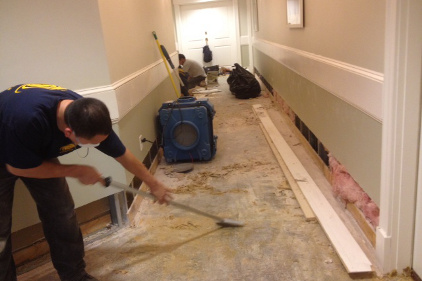The Daisy Chain Method: Increasing Profits and Customer Satisfaction After the Storm
Using all available resources efficiently is the most important way a company can produce the most jobs possible in heavy work volume situations
 If you’ve spent any amount of time in the water damage restoration industry, surely you are familiar with the following scenario: Severe storms roll through your work territory late at night, causing severe flooding to customers within your target market. By the next morning your phones are ringing off the hook with customers in need of water damage emergency services. You have 20 customers lined up and only five crews available to service them.
If you’ve spent any amount of time in the water damage restoration industry, surely you are familiar with the following scenario: Severe storms roll through your work territory late at night, causing severe flooding to customers within your target market. By the next morning your phones are ringing off the hook with customers in need of water damage emergency services. You have 20 customers lined up and only five crews available to service them.
As water damage restorers understand, we work in a bit of a “feast or famine” industry. Summer storms, like those just seen in the Metropolitan Detroit area, and winter cold spells (for those of us in northern regions) can determine whether or not we consider a particular season a business success or failure. Capturing all the work available to us in these situations is key in achieving professional goals and growing our satisfied client base.
I was faced with the above scenario for the first time in 2007 and countless times in the years since. And when tasked with the challenge of trying to capture as much work and gain as many new clients as possible, I decided to implement “The Daisy Chain Method.” Unbeknownst to me, it would completely change the way our company routed crews during storm situations to this day.
Using all available resources efficiently is the most important way a company can produce the most jobs possible in heavy work volume situations. In order for The Daisy Chain Method to work correctly, the business must have at least:
- 1 estimator with a vehicle
- 1 extraction machine
- 6 technicians
- 3 cargo vans and adequate levels of drying equipment/supplies
The Daisy Chain Method is actually quite simple, and begins with splitting employees into four separate teams that will all visit the jobsite on the initial day: the estimator, the extraction crew, the tear out crew, and the equipment setting crew. They are to visit the site in sequence of one another, and they all play an important role in drying the home to industry standards and ending the project with a happy customer.
Team 1: Estimator
As many storm damage claims often have limited insurance coverage, the estimator’s job is most important. Being the first one to visit the site, the estimator’s job is to come to an agreed price/scope with the homeowner (leaving a written copy behind for crews to follow), have all necessary paperwork signed, and collect a 50% down payment for services. The estimator must be competent and knowledgeable (preferably an owner, production manager, or like position) because it is also their job to explain the drying process to the customer and ensure they understand the total scope of work.
Team 2: Extraction/Content Manipulation
Once the estimator has left the site, the extraction crew is next to arrive to remove the bulk of the water by performing extraction services. Drying homes quickly is important so drying equipment and resources can be utilized on other jobs in the coming days. Because of this, emphasis must be placed on performing the extraction thoroughly and a weighted method is suggested. Also included in Team 2’s responsibilities is removing contents from the affected areas to make way for teams that will follow.
Team 3: Tear Out Crew
After the extraction team has gone, the tear out crew (for lack of a better term) arrives to perform necessary material removals in order to dry the structure to IICRC S500 standards. This may include removing carpet, carpet pad, saturated insulation, tackless strips, detaching baseboards, etc. It is important that the estimator’s scope (which is left behind upon initial customer visit) is closely followed in order to ensure customer satisfaction and to prevent any unpleasant surprises to the client. The tear out crew must leave the work area spotless and ready for equipment to be set in order for The Daisy Chain to move quickly. However, they are to leave debris bags outside for the next team to collect as they would have limited van space after performing their specific services in several homes throughout the day.
Team 4: The Equipment Setting Crew
The fourth and final team to visit the site on the initial day of services is the equipment setting crew, whose job is obviously to set the adequate amount of drying equipment for proper structural drying. They are to also apply an antimicrobial agent and an odor counteractant when jobsite conditions and work scope permit doing so. As this team is the last one to visit the customer’s home, it is vital for them to review the estimator’s initial scope to ensure all quoted activities were completed. They must also interact with the customer in order to be certain that they are happy with the activities that had taken place throughout the day. Finally, they are to load the debris bags from Team 3 before returning to the office to dispose of the trash and load more equipment for the next job.
The first time our company attempted The Daisy Chain Method in 2007, we were happy to find that it worked surprisingly well. We were able to produce 9 water damage restoration jobs in a single day with only one estimator and three crews. As with all new work cycle models, we had some minor difficulties along the way, which we corrected before the next storm event took place. The most common problem we found was a team arriving to the jobsite before the prior crew was gone. This was easily corrected and resolved with the arriving crew helping the existing one until the tasks were complete. We now also have a “floater crew” available outside of the chain that is available to help if there is a bog in the system, which almost always results from a homeowner having a basement packed with content.
As with all heavy workload situations, it is crucial to set a realistic customer service expectation. As business owners, managers, and technicians, we sometimes fall into the trap of taking on a heavy initial workload that ends up being near impossible to follow through upon. For those of us in the southeast Michigan region, the recent Warren/Royal Oak/Berkley flooding situation was one we will never forget. But, it is better to have 40 happy customers in a storm event than to have 55 that are upset. By customizing The Daisy Chain Method to your business and its resources, you will be a step closer to a profitable storm event and a larger happy customer base.
Looking for a reprint of this article?
From high-res PDFs to custom plaques, order your copy today!






